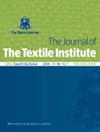氯胺基MOF和PET纤维复合材料高效抑菌
IF 1.5
4区 工程技术
Q2 MATERIALS SCIENCE, TEXTILES
引用次数: 0
摘要
摘要氯胺具有杀菌效率高、合成成本低、无毒、环保、可重复性好等优点。本研究在锆基金属-有机骨架- uio -66- nh2的基础上引入活性氯键基,制备uio -66- nh2抑菌材料,并用浸渍法包覆PET纤维。当UiO-66-NHCl抑菌材料中活性氯含量为8%,浸渍时间为6 h,干燥温度为60℃时,UiO-66-NHCl对PET纤维的负载量最大。采用XRD、SEM、FT-IR、EDS和XPS等表征方法对包覆UiO-66-NHCl抗菌材料的PET纤维进行了分析,并对材料的稳定性、生物安全性和抗菌性能进行了测试。结果表明:UiO-66-NHCl@PET复合纤维经过30天的储存和震动后,氯含量分别保持在原含量的91%和83%,材料的稳定性良好。同时,复合纤维对金黄色葡萄球菌和大肠杆菌均有抑制作用,且抑制圈直径>7 mm,其中对金黄色葡萄球菌的抑制作用优于对大肠杆菌。UiO-66-NHCl@PET复合纤维对金黄色葡萄球菌的抑制活性优于大肠杆菌,抗菌性能优异,无刺激性。研究结果可为生产防护效果优良的医用防护装备提供理论支持。关键词:活性氯;细菌抑制;皮肤给药;碘滴定;披露声明作者未报告潜在的利益冲突。本文章由计算机程序翻译,如有差异,请以英文原文为准。
Chloramine-based MOF and PET fiber composite for efficient bacterial inhibition
AbstractHaloamines have advantages as highly efficient bactericidal, relatively inexpensive synthesis, non- toxic, environmentally friendly and unique reproducibility. In this study, UiO-66-NHCl bacteriostatic material was prepared by introducing reactive chlorine bonding groups based on zirconium-based metal-organic skeleton-UiO-66-NH2, and PET fibers were coated by impregnation method. When the content of reactive chlorine in UiO-66-NHCl bacteriostatic material was 8%, the impregnation time was 6 h, and the drying temperature was 60oC, the maximum amount of UiO-66-NHCl load on PET fibre. We analyzed the PET fibers coated with UiO-66-NHCl antibacterial material by XRD, SEM, FT-IR, EDS and XPS characterization, and tested the stability, biosafety and performance on antibacterial properties of the material. The results showed that the UiO-66-NHCl@PET composite fiber remained 91% and 83% of the original chlorine content after 30 days of storage and shaking, and the stability of the material was good. Meanwhile, the composite fiber inhibited both S. aureus and E. coli, and the diameter of the inhibition circle was >7 mm, in which the inhibition activity of S. aureus was better than that of E. coli. The UiO-66-NHCl@PET composite fiber has better inhibitory activity against S. aureus than E. coli, with excellent antibacterial performance and no irritation. The results can help to provide theoretical support for the production of medical protective equipment with excellent protection effect.Keywords: Active chlorinebacterial inhibitiondermal administrationiodine titrationmetal-organic framework AcknowledgementsThe authors would like to thank (Anonymized).Disclosure statementNo potential conflict of interest was reported by authors.
求助全文
通过发布文献求助,成功后即可免费获取论文全文。
去求助
来源期刊

Journal of the Textile Institute
工程技术-材料科学:纺织
CiteScore
4.20
自引率
5.90%
发文量
149
审稿时长
1.0 months
期刊介绍:
The Journal of The Textile Institute welcomes papers concerning research and innovation, reflecting the professional interests of the Textile Institute in science, engineering, economics, management and design related to the textile industry and the use of fibres in consumer and engineering applications. Papers may encompass anything in the range of textile activities, from fibre production through textile processes and machines, to the design, marketing and use of products. Papers may also report fundamental theoretical or experimental investigations, including materials science topics in nanotechnology and smart materials, practical or commercial industrial studies and may relate to technical, economic, aesthetic, social or historical aspects of textiles and the textile industry.
All published research articles in The Journal of The Textile Institute have undergone rigorous peer review, based on initial editor screening and anonymized refereeing by two expert referees.
 求助内容:
求助内容: 应助结果提醒方式:
应助结果提醒方式:


